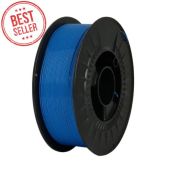We use cookies to make your experience better. Read more
18 April, 2025
TPU Filament Uses: Flexible Solutions for Complex Projects
What is TPU Filament and Why is it So Widely Used?
TPU filament, short for Thermoplastic Polyurethane, is a flexible 3D printing material that combines the strength of plastic with the elasticity of rubber. As a member of the thermoplastic elastomer (TPE) family, TPU stands out for its resilience, stretchability, and versatility across both consumer and industrial applications. Its popularity stems from the fact that it can stretch over five times its original length before breaking, making it a top choice for applications that require flexibility and durability.
Key Properties of TPU Filament
Parts printed with TPU filament exhibit a range of beneficial properties, including excellent shock absorption, impact resistance, vibration dampening, and elasticity. Additionally, TPU is highly resistant to abrasions, oils, greases, chemicals, low temperatures, and shows moderate water resistance. Manufacturers can adjust the hardness and flexibility of TPU by altering the infill percentage during printing or by choosing filaments of varying hardness levels.
Color and Printing Considerations
TPU can be printed in many colors, making it suitable for functional and aesthetic projects alike. Despite its advantages, TPU can be tricky to print due to its flexible nature. However, with the right settings — including slower print speeds (5–30 mm/s), proper nozzle temperature (usually 220°C–250°C), and optimized retraction settings — successful prints are achievable even for intermediate users.
TPU Filament Uses in Industrial and Consumer Applications
Common Application Areas
- Gaskets and seals
- Shock absorbers and vibration-dampening components
- Non-marring workholding fixtures
- Flexible valves and friction pads
- Hoses, drive belts, and straps
- Protective covers and bands
- Prosthetics and orthotic components
- Sporting goods and safety equipment
Benefits for Low-Volume Production
TPU filament enables manufacturers to create custom-shaped parts in low volumes without the added cost and delay of traditional tooling. For instance, companies can quickly produce custom insoles, medical prosthetics, or wearable bands — all tailored to specific user requirements. This is particularly valuable for prototypes or one-off items that would be economically unfeasible using injection molding.
Material Properties That Make TPU So Valuable
Versatility in Strength and Flexibility
- High elasticity and resilience
- Tear, abrasion, and impact resistance
- Performance at low temperatures
- Flexibility without added plasticizers
- Excellent compression set and weather resistance
Real-World Use Cases
This makes TPU an ideal candidate for products that must endure physical stress while remaining pliable. In real-world scenarios, softer TPU grades are used for things like tubing or soft-grip handles, while harder variants are suitable for more rigid components such as caster wheels. Its widespread use in the medical and automotive sectors underscores TPU's reliability under repeated stress and demanding environments.
Challenges of Printing with TPU and How to Overcome Them
Printing with TPU filament is more demanding than with rigid filaments like PLA or ABS. Its soft, flexible nature makes it prone to kinks, clogs, and poor print quality if not handled correctly. For optimal results, it is recommended to:
- Use a direct-drive extruder rather than a Bowden setup
- Ensure the nozzle is clean and clear
- Keep print speeds low (20–30 mm/s)
- Set the nozzle temperature between 220°C and 250°C
- Cold bed is recommended as TPU tends to stick too much
- Minimize or disable retraction
- Use glue stick, painter’s tape, or textured beds for improved adhesion
- Turn on heated bed in case of poor adhesion (50°C)
Moisture Control and Print Quality
TPU is hygroscopic, meaning it absorbs moisture from the air. Moist TPU can lead to bubbles and inconsistent extrusion. To counter this, it's advisable to store the filament in an airtight container with desiccants or dry it in an oven at around 50°C before printing.
Solving Common Print Issues
Common issues like stringing or blobs can often be solved by adjusting temperature and retraction settings. Moreover, TPU’s flexible nature can hinder dimensional accuracy, so it's better suited for functional parts than for high-precision end-use products.
Post-Processing and Handling of TPU Prints
Once printing is complete, TPU parts are relatively easy to handle. The material can be trimmed or cut using scissors or hobby knives. Sanding is also possible with fine-grit sandpaper, though care must be taken to preserve surface integrity. For assembly, TPU parts can be glued using adhesives made for plastics.
Long-Term Performance
TPU’s flexibility also means that it can be used for living hinges, bendable joints, and components requiring frequent motion. Its durability ensures that these parts can endure wear and tear better than many other 3D printed materials.
Comparing TPU to Other Filaments
While TPU filament offers a lot of benefits, it’s not always the best choice for every application. Filaments like PLA and ABS are easier to print and more rigid, making them better for applications that require structural integrity and dimensional accuracy. However, they lack the flexibility that TPU provides.
Why TPU is Preferred for Industry
Other types of TPEs also exist, but most are weaker and more difficult to print than TPU. That makes TPU the most commonly used flexible filament for industrial purposes.
Why TPU Filament Remains an Industry Standard
Despite its challenges, TPU filament remains one of the most popular flexible filaments on the market. Its unique properties — elasticity, durability, and chemical resistance — make it suitable for everything from custom medical equipment to rugged mechanical parts. It’s this versatility that has secured TPU's place in both consumer and industrial 3D printing.
Our Offer at 3D Trček
If you're looking to produce parts that require flexibility, strength, and longevity, TPU filament is an excellent option. At 3D Trček, we specialize in processing a wide range of thermoplastics, including TPU. Whether you need help selecting the right material or you're looking for a complete solution from tool design to final product, our team is here to support your project every step of the way.



Please complete your information below to login.
Anmelden
Neuen Account erstellen